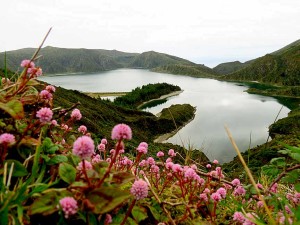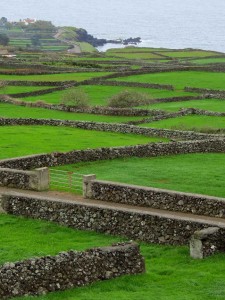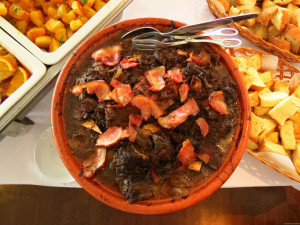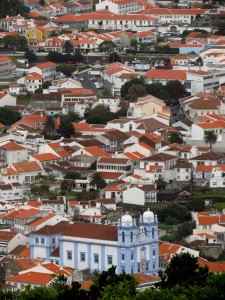Having served as a way station for seafaring vessels since Portuguese explorers stumbled upon its shores in the fifteenth century and as a refueling stop for trans-Atlantic air traffic, the Azores, a chain of nine islands 900 miles west of Portugal, today is becoming ever more of a vacation and business meeting destination for North American travelers.
The natural beauty, rich history, mild sub-tropical climate (55 degrees Fahrenheit in January to the upper 70s in August), and ready access to a wide range of activities, plus the modern amenities many travelers want at reasonable prices, make the Azores attractive, accessible, and affordable.
Only four and a half hours by jet from Boston, the Azores is actively courting U.S. and Canadian travelers to augment the already strong flow of tourists from western Europe and Scandinavia.
Calling it “a lush island paradise in Portugal,” Fodor’s listed the Azores as one of the 25 places to go in 2013. Also this year, the Azores was named the world’s top sustainable tourism destination by QualityCoast, the largest international certification program for sustainable tourism destinations.
Total visitors from the U.S., which surpassed 12,000 in 2012 (up 24 percent from the year before), posted a 12 percent gain through September 2013, while room-nights logged by U.S. travelers grew 30 percent. Canadian tourism, with slightly less than half the numbers of the U.S., likewise, grew 13 percent in the first nine months of 2013.
Cruise ship traffic is also rising dramatically, with 122 ships docking at Azorean ports in 2012, a 30 percent jump over 2011. Cruise calls in 2013, including 29 inaugural calls, were expected to continue near 2012 levels. Helping to boost this traffic have been new cruise terminals in Ponta Delgada on São Miguel and Horta on Faial island
Building on this momentum, the Azores Promotion Board will pursue an aggressive agenda in North America in 2014 – by enhancing brand awareness through trade and consumer shows, roadshows, and workshops, expanding its recently launched online marketing campaign, reaching out to tour operators, and hosting fam trips for travel professionals.
To support the effort, SATA, Portugal’s second largest airline after TAP, is increasing its service from North America to Ponta Delgada. Flights from Boston will increase from three a week to a daily schedule by the summer of 2014; Toronto service will increase from four to six flights a week.
A Historic Port of Call
The Azores, an autonomous region of Portugal extending over 370 miles, comprises three groups: the eastern group of São Miguel and Santa Maria, the central group of Terceira, Faial, Graciosa, Pico, and São Jorge, and the western group of Corvo and Flores. São Miguel island is the largest at just under 300 square miles, while Corvo, the smallest, is seven square miles (by comparison, Bermuda is 21 square miles.)
The islands were discovered in 1427 by the Portuguese explorer Diogo de Silves. Two years later, Prince Henry the Navigator (the Infante Dom Henrique) was granted a charter to start a settlement. Christopher Columbus’ stop at Santa Maria island in 1493, on his way home from the Antilles, may have initiated the centuries-long practice, which continued through World War II, of using the Azores as a strategic port of call for ships crossing the Atlantic.
Though transoceanic travel foretold a robust economic future for the Azores, merchant ship traffic diminished after a sea route linking Europe and India was discovered in the sixteenth century. However, the U.S. Air Force still shares a base with the Portuguese Air Force, the Azores Air Zone Command, and commercial traffic, near Angra do Heroísmo on Terceira island, the largest island in the chain.
Being physically isolated, where every manufactured item must be imported, one would expect prices to be higher in the Azores than on the Portuguese mainland. However, largely due to tax policy, the opposite is true. For example, the many restaurants and sidewalk cafes on and around the Avenida Infante Dom Henrique, which rims Ponta Delgada‘s port, all offer high-quality, freshly prepared island cuisine at reasonable prices.
Old World Hospitality and Natural Beauty
Walk into any establishment in the Azores—a store, restaurant, hotel, museum—and you’ll be welcomed with the warm “Bom dia!” Azoreans use to greet each other, reflecting an openness and hospitality that is part and parcel of island life.
Say “Azores” and one immediately conjures a picture of an undulating landscape shaped by volcanoes covered with lush green vegetation that often runs to the lava-dotted coast, be it basalt cliffs along the north of most of the islands or more gentle rolling hills that lead to the sea on their southern edge.
With the exception of Santa Maria island, volcanic craters, domes, cones, lava shields, and fumaroles, some of which emit hot gases and boiling water, punctuate the landscape of the other eight islands. The volcanos are now quiet, though a slow, low-level eruption occurred undersea off the coast of Terceira between 1998 and 2001.
Terceira’s Cinco Picos crater, about five miles in diameter, now filled in, is actively worked as farm land. São Miguel’s Lagoa das Sete Cidades (Lagoon of the Seven Cities) fills most of a large volcanic crater and is home to a thriving village. This same approach to sustainable development led the islands of Corvo, Flores, and Graciosa to be designated UNESCO Biosphere Reserves.
In the spring and summer blossoming azaleas, lilies, camellias, hibiscus, and bougainvillea create a multi-hued, floral cornucopia. Blue, pink, and white hydrangea line the (good quality) back roads of São Miguel, making even the most casual drive a visually rich experience.
Numerous microclimates, influenced by the presence of volcanoes, particularly on São Miguel, yield a wide variety of plants that include evergreens, Brazilian yellow-woods, Australian eucalyptus, Japanese cedar, as well as the towering New Zealand Christmas Tree. Bananas, tobacco, and pineapples are cultivated on the island, which is home to the Goreanna tea plantation, the only one in Europe.
Hearty Cuisine Based on Local Fare
Agriculture, dairy and cattle farming, and fishing, the traditional industries of the islands, have nurtured a cuisine that emphasizes country fare. On São Miguel, be sure to try cozido das Furnas, a stew made of beef, pork, chicken, sausages, white and sweet potatoes, yam, and white, red, and green cabbage. Better yet, go to Parque de Campismo das Furnas where you can cook your cozido underground in a natural oven warmed by geothermal activity. Restaurante Vale das Furnas will also cook it there for you and serve it with a robust Alentejano red wine.
The alcatra com massa sovada, which hails from Terceira, a beef stew made with bacon and served with a sweetened bread, is hearty, flavorful, and as authentic as Azorean cuisine gets.
When in Angra do Heroísmo, stop at the Beira Mar restaurant on Canada do Porto and get a table on the veranda overlooking the bay. The sopa do pao, a shrimp bisque served in a bowl made of bread, is a must. Follow it with pleasantly spiced roasted grouper and finish off your meal with fruit salad or a sweet confection and the always superb espresso.
You’ll also want to try the locally produced Vaquinha cheese, a mild, soft yellow product, and Queijada, a biscuit-like confectionary made with cheese.
The Azores produces Verdelho wine, the original grapes for which came from Sicily five centuries ago, though most wine consumed on the island is imported from the mainland. In Terceira, a complex network of stone walls made from lava rocks has been built to protect the vines from the wind and seawater. UNESCO declared a similar landscape on Pico, the second largest island in the Azores, a world heritage site.
Activities to Suit a Wide Range of Interests
Numerous activities will keep visitors as busy as they want, be it hiking, mountain biking, bird watching, golf, horseback riding, fishing, scuba diving, surfing, windsurfing, sailing, or canoeing. Not least is dolphin and whale watching, as the archipelago is regarded as one of the top 10 whale watching sites in the world. Swimming is available although the Azores doesn’t have the wide stretches of beach found elsewhere.
As a part of Iberia, the Azores offers its homegrown version of bull sport. In Terceira during the summer months, bulls tethered to a rope run through streets in pursuit of local men looking to demonstrate their fearlessness.
The 31-acre Terra Nostra Botanical Park on São Miguel, which originated as an estate built in 1775 by U.S. consul Thomas Pickering, provides a quiet respite and an opportunity to take in a wide variety of Azorean flora, including 600 varieties of camellia and 300 types of fern. You can even take a dip in a geothermal water pool.
Strolling the streets is, as always, a great way to become acquainted with new places. Angra do Heroísmo’s Rua da Sé, a main thoroughfare dating to the 15th century, unusually wide for its time, is one reason the city’s historical center became a UNESCO world heritage site. The balconies fronting many local buildings were made from iron brought back from England in the 1860s and 1870s in exchange for Azorean oranges.
After a 1980 earthquake destroyed most of Angra, its buildings were rebuilt in their original style. Numerous monuments and churches, however, as well as the comprehensive Museum of Angra do Heroísmo, impart a sense of the history and pride of Terceira.
White-washed houses, with windows and doors trimmed in color—typically blue, red, forest green, lime green, gray, yellow, or brown—one after the other, create a visual link to communities of old. Outside the main towns, you may see a bag of bread hanging on the front doors of some homes where homeowners have left money for the bread man who delivers daily.
Staying in Angra do Heroísmo and Ponta Delgada
The Terceira Mar Hotel in Angra, which sits on the ocean opposite Mount Brazil, has 139 guest rooms, all with air conditioning, TV, phone, wireless access, and private balconies. A fitness center, conference and meeting rooms, and an expansive reading lounge, make the property ideal for business groups and individual travelers.
Hotel Marina Atlântico, overlooking the port in Ponta Delgada, offers similar amenities, but with 184 guest rooms, it can accommodate slightly larger groups.
The Azores, www.visitazores.com, www.flytoazores.com






